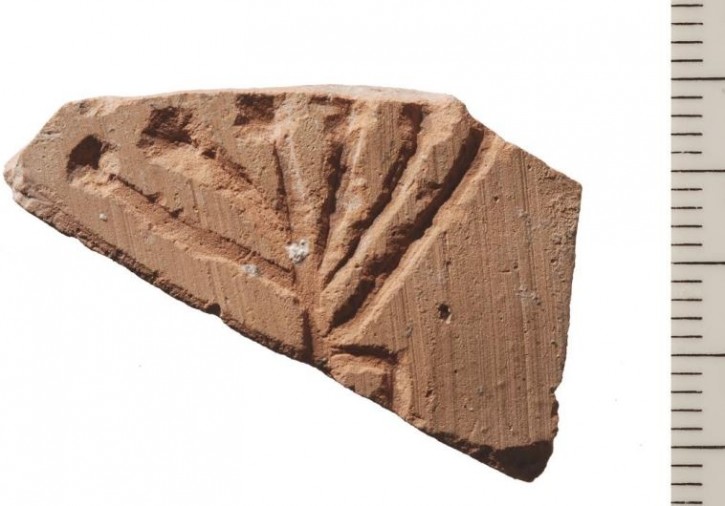 Jerusalem – A 1,000-year-old potsherd from the Temple Mount bearing a symbol resembling a menorah may shed invaluable light on a centuries-old debate regarding the menorah’s original design, a noted archaeologist announced on Thursday.
Jerusalem – A 1,000-year-old potsherd from the Temple Mount bearing a symbol resembling a menorah may shed invaluable light on a centuries-old debate regarding the menorah’s original design, a noted archaeologist announced on Thursday.
Subscribe to our Daily Roundup Email
The relic was recently discovered at the Temple Mount Sifting Project in Jerusalem, which sifts through the thousands of tons of ancient debris illegally discarded from the contested holy site by the Islamic Wakf in 1999.
Although archaeologist Zachi Dvira, co-founder and director of the project, could not see the entire design of the broken sherd, he said that it likely represented an attempt to draw the Temple’s menorah.
“Based on its clay type and texture, the potsherd dates to the period of Byzantine rule over Jerusalem, from 324 to 640 CE,” said Dvira.
“What makes this discovery significant is that it originated upon the Temple Mount itself. The design of the menorah inscribed on the potsherd may shed light on an age-old debate regarding the appearance of the menorah that stood in the Heikal (hall) of the First and Second Temples.”
According to Dvira, the origins for the design of the menorah can be found in the Book of Exodus (25:32-40), which states:
“And you shall make a menorah of pure gold. The menorah shall be made of hammered work; its base and its stem, its goblets, its knobs, and its flowers shall all be one piece with it. And six branches coming out of its sides: three menorah branches from its one side and three menorah branches from its second side… so for the six branches that come out of the menorah… And you shall make its lamps seven…”
Still, the Biblical passage does not provide any indication as to whether the branches of the menorah were meant to be round or straight, leading to a protracted debate among leading rabbinic scholars, including Rabbi Shlomo Yitzhaki – Rashi (1040-1105), Rabbi Abraham ibn Ezra (1089-1167), and Maimonides (1135-1204).
“Upon the potsherd, the furthermost left branch of what appears to be a menorah cannot be fully seen due to the fracture at that side,” explained Dvira.
“The base of the menorah can partly be seen, and was probably composed of three legs; two angular and one straight. At the top, one sees that the branches are polygonal depressions which may represent the almond shaped cups that held the oil for the wicks.”
The branches on the engraving are straight, unlike other ancient representations of the menorah from antiquity, where they appear in a circular fashion, he noted, which may be due to the fact that “it is very difficult to create circular lines when engraving a potsherd.”
“As the potsherd dates to centuries after the destruction of the Second Temple, and the incision was done after firing the clay, it is difficult to deduce from it anything concrete regarding the original shape of the menorah,” Dvira said.
“But, we can learn about how Jews living in Jerusalem during the Byzantine period, or later, understood the design of the menorah.”
The Temple Mount Sifting Project – under the auspices of Bar-Ilan University, and with the support of the City of David Foundation – was created by Dvira and internationally-recognized archaeologist Gabriel Barkay in an effort to reclaim, analyze and document the discarded debris.
“Even now we have new information that may well change the written history of some of the periods of the Temple Mount,” Barkay said of the project.
He added: “The sifting project has proven itself to be an inexhaustible source of knowledge for the research and study of the archaeology and history of the Temple Mount.”

Do not know what exactly they found now.
If you go to Rome Italy and stand under the infamous Titus H’Rasha Arch,you can see the artist sculpture rendition of Jews carrying the Menorah from the Bais Hamikdash while going into Golus and arriving in Rome at that exact time period and you will see that the Menorah they are carrying into Rome is rounded arm branches!!
You can google it up and stand under it without having to go actually be there and see it
MS Arch
Hashgacha protis they found this on chanukah
It has strait branches exactly as rashi and the the rambam say
And there is a drawing of the menora from the rambam himself which is drawn with strait arms
This cannot be a depiction off the Menorah from the Bais Hamikdash it has only six branches.
#1
come on man, what a non Jewish artist depicted is not actually what he saw.
If his assumption is true, which we don’t have any prove, than the seventh and the eight branches is on the left side, than the left side of menorah would be horizontal rending inoperable.